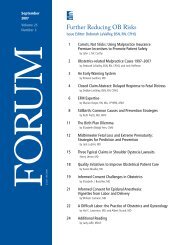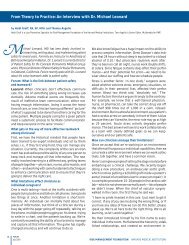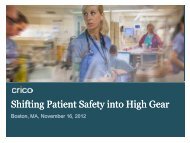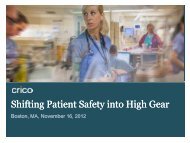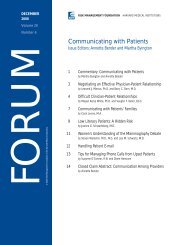How a Captive Insurer Uses Data and Incentives to - Risk ...
How a Captive Insurer Uses Data and Incentives to - Risk ...
How a Captive Insurer Uses Data and Incentives to - Risk ...
Create successful ePaper yourself
Turn your PDF publications into a flip-book with our unique Google optimized e-Paper software.
3- The controls fall easily <strong>to</strong> h<strong>and</strong> without changing grip <strong>and</strong> a clearlayout avoids confusion. Drive direction <strong>and</strong> travel speed arecontrolled by a butterfly switch with integral but<strong>to</strong>ns for hoist <strong>and</strong>lower functions.- Footrests on the right of the footwell prevent fatigue during longhorizontal transport runs.- St<strong>and</strong>ard display gives battery discharge, operating hours <strong>and</strong> faultcode read-outs.1890Chassis.- Very good all round vision <strong>and</strong> a clear view on<strong>to</strong> the fork tipsthanks <strong>to</strong> the new rounded chassis con<strong>to</strong>urs.- Robust, <strong>to</strong>rsionally rigid steel frame consists of drive section <strong>and</strong>load lifting section.- A patented hinged section gives ideal access <strong>to</strong> the electricalcomponents. Ease of servicing reduces maintenance costs.- Good weight distribution <strong>and</strong> reduced point loading due <strong>to</strong> the4-wheel principle - ideal for upper s<strong>to</strong>rey use.- Patented friction aids on the fork tips allow non-slip palleth<strong>and</strong>ling.22251345940 19012228070169 1450930 12009080Steering.- Full electric steering for 180° lock-<strong>to</strong>-lock movement withoutkickback. Steering wheel diameter of only 120 mm<strong>and</strong> 4½ turns guarantees fast, effortless steering.- The steer mo<strong>to</strong>r is protected against shocks from uneven floorsby a safety coupling.- Au<strong>to</strong>matic reduction of speed when driving round corners,thereby ensuring a high level of safety.7965071630184564Drive.- A robust 2.0 kW shunt wound drive mo<strong>to</strong>r provides quickacceleration <strong>and</strong> powerful ramp travel. Efficient energy utilisationdue <strong>to</strong> the spur <strong>and</strong> bevel gear transmission.10023401150460 100Hydraulics.- The hydraulic unit consists of a powerful, high efficiency 3.0 kWpump mo<strong>to</strong>r actuated via push but<strong>to</strong>ns in the operating panel.- Particularly sensitive control is achieved with the proportionalvalve technology fitted as st<strong>and</strong>ard for the main hoist.- Au<strong>to</strong>matic shut-off of the initial lift is achieved by anoverload protection for the hydraulic pump - saving energy <strong>and</strong>reducing noise.Brakes.- Two independent braking systems are fitted.- Genera<strong>to</strong>r braking activated by releasing the butterfly switch orchanging drive direction guarantees soft braking <strong>and</strong> protects thebrake linings. During braking the drive unit acts as a genera<strong>to</strong>r <strong>and</strong>puts the recovered energy back in<strong>to</strong> the battery.- An electromagnetic brake acts as a parking brake <strong>and</strong>emergency brake.- Starting on gradients is possible without roll-back.- Au<strong>to</strong>matic brake moni<strong>to</strong>ring is achieved by means of a loadsensor, which regulates the braking current <strong>to</strong> suit the load.Battery.- For multi-shift use the battery is changed using the patentedbattery free lift <strong>and</strong> a roller track at the side.Auxiliary equipment.- Wheel position indica<strong>to</strong>r.- Return control.- FleetManager light.
ADVANCING PATIENT SAFETYchange. We’d like <strong>to</strong> be able <strong>to</strong> use the data, the educationalcontent, <strong>and</strong> the impact from the educational content <strong>to</strong> makethe business case <strong>to</strong> the chiefs of service or hospital-based leadership,that these educational core components shouldbecome a term of credentialing. That’s where we’d like <strong>to</strong> seethe tipping point.”Being able <strong>to</strong> provide highly specific data <strong>to</strong> administra<strong>to</strong>rs<strong>and</strong> providers is a significant boon <strong>to</strong> engaging them in creating<strong>and</strong> sustaining solutions. Because CRICO/RMF maintainscentralized, in-house data collection services, claims data arecoded according <strong>to</strong> a common language <strong>and</strong> taxonomy, providinga robust body of evidence regarding specific areas ofvulnerability within a practice, institution, or group of institutions.Using the claims database, CRICO/RMF staff canshow, for example, that a hospital’s obstetrics department hasa relatively high rate of shoulder dys<strong>to</strong>cia claims that involvedcommunication gaps between residents <strong>and</strong> attending physicians.On a more global level, the organization can identifythe locations within clinical processes where gaps are mostlikely, stating, for example, that across the Harvard system61% of the dollar losses associated with outpatient diagnosisrelatedclaims involved problems with the ordering of diagnostictests.The organizational leaders at CRICO/RMF also recognizethat each Harvard-affiliated institution has a unique culture<strong>and</strong> that the most effective approach for implementing sustainablepatient safety interventions will vary from one institution<strong>to</strong> another. When working with hospital administra<strong>to</strong>rs<strong>and</strong> providers <strong>to</strong> encourage the adoption <strong>and</strong> spread of patientsafety practices, CRICO/RMF staff tries <strong>to</strong> remain cognizant ofthe existing culture. According <strong>to</strong> Kenneth S<strong>and</strong>s, MD, seniorvice president of health care quality at Beth Israel DeaconessMedical Center in Bos<strong>to</strong>n, CRICO/RMF staff provides “cus<strong>to</strong>mizedinitiatives, which create uniquely valuable offeringsbecause they’re not ‘cookie cutter.’”Clients of RMF Strategies also have benefited from theCRICO/RMF approach of “leading with the data.” Larry Smith,vice president of risk management of MedStar Health, a healthsystem <strong>and</strong> captive insurer in the Maryl<strong>and</strong>-D.C. area, says hisorganization created an obstetrics risk reduction task force,provided task force members with data that had been collected<strong>and</strong> analyzed using the claims management software developedby RMF Strategies, <strong>and</strong> let the group determine potential solutions.“In the last eight years, this obstetrics program has beenone of the most visible patient safety-risk reduction initiativesacross the system. The obstetricians are envied by many of thephysicians elsewhere in the hospital system because they havecome <strong>to</strong>gether as a collective group, have a system-wide identityas a group, <strong>and</strong> have become patient safety experts in theirown right...It has transformed the way our obstetrics departmentlooks at patient safety.” Smith says that patient outcomes,such as cesarean section rates <strong>and</strong> APGAR scores haveimproved due <strong>to</strong> the risk reduction program. In addition, sincethe intervention, the obstetrics-related claims rate remainslower than anticipated based on previous experience.Figure 1. Breast Cancer Cases 1987–2008CRICO/RMF staff crafts a variety of risk reduction <strong>to</strong>olsbased on needs identified through claims data <strong>to</strong> help providersidentify <strong>and</strong> mitigate gaps in care processes that increase the riskof an error. For example, data analysts at CRICO/RMF identifiedan increase in claims related <strong>to</strong> failure <strong>to</strong> diagnose in the ambula<strong>to</strong>rysetting. One area of specific need that emerged was breastcancer diagnosis. CRICO/RMF staff worked with clinical experts<strong>to</strong> develop decision support <strong>to</strong>ols for the diagnosis of breast cancer.One <strong>to</strong>ol, the Breast Care Management Algorithm, is used <strong>to</strong>remind providers of potential pitfalls in diagnosis, such as failure<strong>to</strong> create a system for tracking ordered tests <strong>and</strong> outside referrals<strong>to</strong> ensure notification of test results <strong>and</strong> referral outcomes. Workon the algorithm began in the early 1990s, when CRICO-insuredprimary care providers expressed concern over the frequency ofmalpractice claims alleging a failure <strong>to</strong> diagnose breast cancer.The first iteration was published in 1995; the document has beenrevised four times, culminating in the most recent (2009) edition.(View the algorithm at http://www.rmf.harvard.edu/files/documents/cricormf_bca.pdf.)Figure 2: Rate of Anesthesia Cases Before <strong>and</strong> After Initiation of Simulation Training22Patient Safety & Quality Healthcare ■ November/December 2009 www.psqh.com
ADVANCING PATIENT SAFETYing has reduced obstetric claims makes sense,“The obstetrician who finished training 30years ago is probably not up on facing shoulderdys<strong>to</strong>cia or complicated deliveries,because of the emerging technology <strong>and</strong> thefact that they just haven’t had <strong>to</strong> face these situationsvery often at all. For any low-frequencyevent, simulation is very, very useful.”The simulation training also has beeneffectively applied at community hospitals.Mitchell S. Rein, MD, chief medical officer<strong>and</strong> senior vice president of medical affairs atNorth Shore Medical Center in Salem, Massachusetts,notes that the program was“Hugely successful. We’re still applying someof the lessons that we learned from the initiative<strong>to</strong> other areas such as the operatingrooms <strong>and</strong> our hospitalist program. Obstetricsis a multidisciplinary effort, <strong>and</strong> the simulation<strong>and</strong> teamwork training lends itself <strong>to</strong>improving a variety of the human fac<strong>to</strong>rs in healthcare.”According <strong>to</strong> one survey, the majority of participants of thesimulation program reported having experienced a criticalclinical event since taking the course <strong>and</strong> that aspects of teamworkhad either significantly or somewhat improved due <strong>to</strong> thetraining (Gardner, 2008). Additionally, 90% stated they hadresponded better <strong>to</strong> critical events, <strong>and</strong> 87% reported that theycommunicated more effectively during the most significantcritical event that occurred since taking the course.The obstetrics team training premium discount programoffers a savings of 10% for each insured physician or nursemidwife. Over the five years of the program’s existence,CRICO/RMF has refunded more than $5 million back <strong>to</strong> participatingpractices <strong>and</strong> hospitals.SIX TIPS FOR SUCCESSFUL PATIENT SAFETY INITIATIVES1. Develop relationships with individuals at various levels of the departmen<strong>to</strong>r organization of focus.2. Get <strong>to</strong> know your clinicians: What are the pain points for each subgroupof providers?3. Never underestimate the power of culture: Assess the degree <strong>to</strong> whichyour organization has a patient safety culture. If it needs a boost,mobilize respected clinical experts within your organization <strong>to</strong> championnew initiatives <strong>and</strong> <strong>to</strong> encourage hesitant providers <strong>to</strong> join them.4. Collect <strong>and</strong> analyze data so you can provide detailed information thatis actionable.5. Convene the right group of individuals, present them with relevantdata, <strong>and</strong> let them identify gaps <strong>and</strong> brains<strong>to</strong>rm solutions on theirown.6. Support resulting patient safety efforts with incentives; remember thatmany important incentives are nonfinancial, such as academicadvancement <strong>and</strong> work-life considerations.ConclusionPatient safety is a <strong>to</strong>p priority <strong>to</strong> many constituents <strong>and</strong> organizations<strong>to</strong>day. The CRICO/RMF strategy for promotingpatient safety initiatives in its owner hospitals is <strong>to</strong> build keyrelationships with leaders <strong>and</strong> providers, present detailed,actionable data, <strong>and</strong> provide financial incentives, with the endgoal of shifting providers <strong>to</strong>ward practices that reduce the riskof error. Premium incentive programs based on simulationtraining are examples of a specific <strong>to</strong>ol that CRICO/RMF leadershave successfully utilized <strong>to</strong> promote patient safety at Harvard-affiliatedorganizations. Leaders of healthcare organizations<strong>and</strong> patient safety champions can apply similarapproaches for implementing patient safety initiatives at theirorganizations. ❙PSQHTranslating the CRICO/RMF Strategy <strong>to</strong>Healthcare OrganizationsDespite the disadvantage of having weaker leverage points forshifting practice patterns than entities that control salaries <strong>and</strong>credentialing, CRICO/RMF staff has engaged providers in successfulpatient safety initiatives. The strategies that CRICO/RMFleaders used <strong>to</strong> create <strong>and</strong> sustain these initiatives can also beapplied by healthcare executives <strong>and</strong> patient safety champions <strong>to</strong>plan, implement, <strong>and</strong> sustain patient safety efforts. The overallstrategy used by CRICO/RMF leaders <strong>and</strong> staff is <strong>to</strong> “lead withthe data.”Their goal is <strong>to</strong> collect <strong>and</strong> present consistent, accurate,actionable data that are sufficiently detailed <strong>to</strong> inspire behaviorchange <strong>and</strong> action supportive of patient safety. Presenting thedata <strong>to</strong> individuals capable of the changes needed <strong>to</strong> improvepatient safety requires the development of relationships at alllevels of the organization. Finally, use of incentives often is necessaryfor capturing the attention of busy clinicians <strong>and</strong> encouragingthem <strong>to</strong> prioritize time, energy, <strong>and</strong> thought for a newpatient-related activity. (See sidebar for six specific tips forpatient safety initiatives.)Diane Shannon specializes in writing about performanceimprovement, patient safety, <strong>and</strong> quality in healthcare. As apracticing internist, she saw gaps in care processes that prompted her<strong>to</strong> pursue public health training <strong>to</strong> gain a broader perspective onsolutions. A full-time freelance writer for the last decade, she uses herclinical experience <strong>and</strong> writing skills <strong>to</strong> draw attention <strong>to</strong> deficienciesin the healthcare system <strong>and</strong> <strong>to</strong> highlight innovative programs forchange. She can be reached at dshannon@mdwriter.com.REFERENCESGardner R., Walzer T.B., Simon R., & Raemer D.B. (2008) Obstetricsimulation as a risk control strategy: course design <strong>and</strong>evaluation. Simulation in Healthcare, 3(2),119-127.Institute of Medicine. Committee on Quality of Health Care inAmerica. (2000). To err is human; Building a safer health caresystem. L. T. Kohn, J. M.Corrigan, & M. S. Donaldson (Eds.).Washing<strong>to</strong>n, DC: National Academy Press.National Quality Forum. Safe Practices for BetterHealthcare–2009 Update: A Consensus Report. Washing<strong>to</strong>n,DC: National Quality Forum; 2009.26Patient Safety & Quality Healthcare ■ November/December 2009 www.psqh.com



